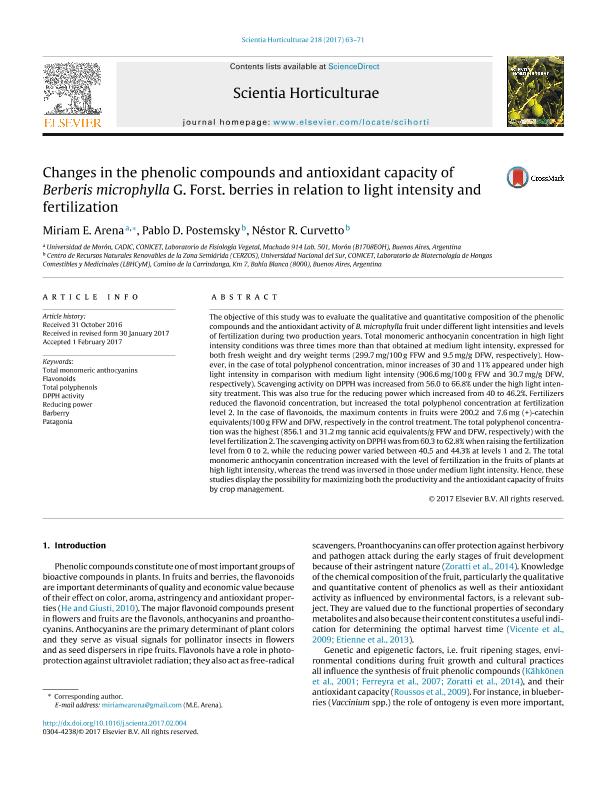Mostrar el registro sencillo del ítem
dc.contributor.author
Arena, Miriam Elisabet

dc.contributor.author
Postemsky, Pablo Daniel

dc.contributor.author
Curvetto, Nestor Raul

dc.date.available
2017-09-26T20:12:03Z
dc.date.issued
2017-04
dc.identifier.citation
Arena, Miriam Elisabet; Postemsky, Pablo Daniel; Curvetto, Nestor Raul; Changes in the phenolic compounds and antioxidant capacity of Berberis microphylla G. Forst. berries in relation to light intensity and fertilization; Elsevier Science; Scientia Horticulturae; 218; 4-2017; 63-71
dc.identifier.issn
0304-4238
dc.identifier.uri
http://hdl.handle.net/11336/25167
dc.description.abstract
The objective of this study was to evaluate the qualitative and quantitative composition of the phenolic compounds and the antioxidant activity of B. microphylla fruit under different light intensities and levels of fertilization during two production years. Total monomeric anthocyanin concentration in high light intensity conditions was three times more than that obtained at medium light intensity, expressed for both fresh weight and dry weight terms (299.7 mg/100 g FFW and 9.5 mg/g DFW, respectively). However, in the case of total polyphenol concentration, minor increases of 30 and 11% appeared under high light intensity in comparison with medium light intensity (906.6 mg/100 g FFW and 30.7 mg/g DFW, respectively). Scavenging activity on DPPH was increased from 56.0 to 66.8% under the high light intensity treatment. This was also true for the reducing power which increased from 40 to 46.2%. Fertilizers reduced the flavonoid concentration, but increased the total polyphenol concentration at fertilization level 2. In the case of flavonoids, the maximum contents in fruits were 200.2 and 7.6 mg (+)-catechin equivalents/100 g FFW and DFW, respectively in the control treatment. The total polyphenol concentration was the highest (856.1 and 31.2 mg tannic acid equivalents/g FFW and DFW, respectively) with the level fertilization 2. The scavenging activity on DPPH was from 60.3 to 62.8% when raising the fertilization level from 0 to 2, while the reducing power varied between 40.5 and 44.3% at levels 1 and 2. The total monomeric anthocyanin concentration increased with the level of fertilization in the fruits of plants at high light intensity, whereas the trend was inversed in those under medium light intensity. Hence, these studies display the possibility for maximizing both the productivity and the antioxidant capacity of fruits by crop management.
dc.format
application/pdf
dc.language.iso
eng
dc.publisher
Elsevier Science

dc.rights
info:eu-repo/semantics/openAccess
dc.rights.uri
https://creativecommons.org/licenses/by-nc-sa/2.5/ar/
dc.subject
Barberry
dc.subject
Dpph Activity
dc.subject
Flavonoids
dc.subject
Patagonia
dc.subject
Reducing Power
dc.subject
Total Monomeric Anthocyanins
dc.subject
Total Polyphenols
dc.subject.classification
Bioquímica y Biología Molecular

dc.subject.classification
Ciencias Biológicas

dc.subject.classification
CIENCIAS NATURALES Y EXACTAS

dc.title
Changes in the phenolic compounds and antioxidant capacity of Berberis microphylla G. Forst. berries in relation to light intensity and fertilization
dc.type
info:eu-repo/semantics/article
dc.type
info:ar-repo/semantics/artículo
dc.type
info:eu-repo/semantics/publishedVersion
dc.date.updated
2017-09-19T14:42:00Z
dc.journal.volume
218
dc.journal.pagination
63-71
dc.journal.pais
Países Bajos

dc.journal.ciudad
Amsterdam
dc.description.fil
Fil: Arena, Miriam Elisabet. Universidad de Morón; Argentina. Consejo Nacional de Investigaciones Científicas y Técnicas. Centro Austral de Investigaciones Científicas; Argentina
dc.description.fil
Fil: Postemsky, Pablo Daniel. Consejo Nacional de Investigaciones Científicas y Técnicas. Centro Científico Tecnológico Conicet - Bahía Blanca. Centro de Recursos Naturales Renovables de la Zona Semiárida. Universidad Nacional del Sur. Centro de Recursos Naturales Renovables de la Zona Semiárida; Argentina
dc.description.fil
Fil: Curvetto, Nestor Raul. Consejo Nacional de Investigaciones Científicas y Técnicas. Centro Científico Tecnológico Conicet - Bahía Blanca. Centro de Recursos Naturales Renovables de la Zona Semiárida. Universidad Nacional del Sur. Centro de Recursos Naturales Renovables de la Zona Semiárida; Argentina
dc.journal.title
Scientia Horticulturae

dc.relation.alternativeid
info:eu-repo/semantics/altIdentifier/url/http://www.sciencedirect.com/science/article/pii/S0304423817300894
dc.relation.alternativeid
info:eu-repo/semantics/altIdentifier/doi/http://dx.doi.org/10.1016/j.scienta.2017.02.004
Archivos asociados
